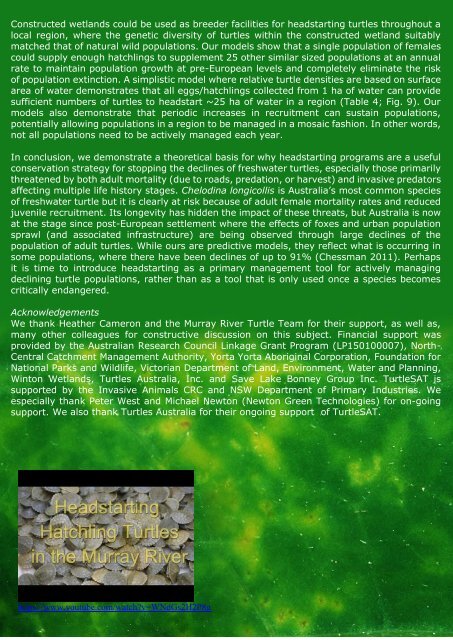Preventing Freshwater Turtle Extinctions
Critically Evaluating Best Management Practices For Preventing Freshwater Turtle Extinctions
Critically Evaluating Best Management Practices For Preventing Freshwater Turtle Extinctions
- No tags were found...
You also want an ePaper? Increase the reach of your titles
YUMPU automatically turns print PDFs into web optimized ePapers that Google loves.
Constructed wetlands could be used as breeder facilities for headstarting turtles throughout a<br />
local region, where the genetic diversity of turtles within the constructed wetland suitably<br />
matched that of natural wild populations. Our models show that a single population of females<br />
could supply enough hatchlings to supplement 25 other similar sized populations at an annual<br />
rate to maintain population growth at pre-European levels and completely eliminate the risk<br />
of population extinction. A simplistic model where relative turtle densities are based on surface<br />
area of water demonstrates that all eggs/hatchlings collected from 1 ha of water can provide<br />
sufficient numbers of turtles to headstart ~25 ha of water in a region (Table 4; Fig. 9). Our<br />
models also demonstrate that periodic increases in recruitment can sustain populations,<br />
potentially allowing populations in a region to be managed in a mosaic fashion. In other words,<br />
not all populations need to be actively managed each year.<br />
In conclusion, we demonstrate a theoretical basis for why headstarting programs are a useful<br />
conservation strategy for stopping the declines of freshwater turtles, especially those primarily<br />
threatened by both adult mortality (due to roads, predation, or harvest) and invasive predators<br />
affecting multiple life history stages. Chelodina longicollis is Australia’s most common species<br />
of freshwater turtle but it is clearly at risk because of adult female mortality rates and reduced<br />
juvenile recruitment. Its longevity has hidden the impact of these threats, but Australia is now<br />
at the stage since post-European settlement where the effects of foxes and urban population<br />
sprawl (and associated infrastructure) are being observed through large declines of the<br />
population of adult turtles. While ours are predictive models, they reflect what is occurring in<br />
some populations, where there have been declines of up to 91% (Chessman 2011). Perhaps<br />
it is time to introduce headstarting as a primary management tool for actively managing<br />
declining turtle populations, rather than as a tool that is only used once a species becomes<br />
critically endangered.<br />
Acknowledgements<br />
We thank Heather Cameron and the Murray River <strong>Turtle</strong> Team for their support, as well as,<br />
many other colleagues for constructive discussion on this subject. Financial support was<br />
provided by the Australian Research Council Linkage Grant Program (LP150100007), North-<br />
Central Catchment Management Authority, Yorta Yorta Aboriginal Corporation, Foundation for<br />
National Parks and Wildlife, Victorian Department of Land, Environment, Water and Planning,<br />
Winton Wetlands, <strong>Turtle</strong>s Australia, Inc. and Save Lake Bonney Group Inc. <strong>Turtle</strong>SAT is<br />
supported by the Invasive Animals CRC and NSW Department of Primary Industries. We<br />
especially thank Peter West and Michael Newton (Newton Green Technologies) for on-going<br />
support. We also thank <strong>Turtle</strong>s Australia for their ongoing support of <strong>Turtle</strong>SAT.<br />
13<br />
Spencer R-J et al. 2017 Critically Evaluating Best Management Practices for <strong>Preventing</strong> <strong>Freshwater</strong> <strong>Turtle</strong><br />
<strong>Extinctions</strong>. Conservation Biology. In Press.<br />
https://www.youtube.com/watch?v=WNdGs2H2P8g


